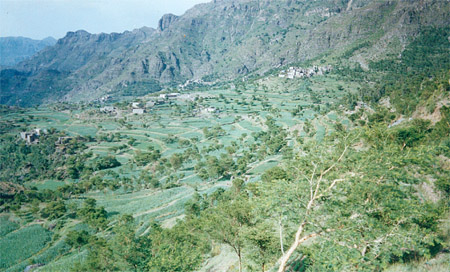
Agricultural Domestic Product Declines & Water Crisis Threatens People’s Life [Archives:2001/30/Business & Economy]
July 23 2001

Mahyoub Al-Kamali
Yemen suffers from a clear shortage in water resources, mainly due to remarkable growth of people in towns and arbitrary use of underground water in the countryside. On the other hand, Qat plants consumes between 50-60% of irrigation and drinkable water. With the scarcity of water and seeping away underground water, possibilities of people’s conflict for water resources becomes bigger.
Scarcity of water has actually a negative impact on agricultural activities. Local production of fruits and cereals has remarkably dropped. This has incurred many workers being laid off in the agricultural and animal fields.
According to statistics issued by the WB the annual renewable rate of water resources reaches to 2,1 billion m3. The rate goes down for the individual share reaching 150 m3 annually in comparison to 1250 m3 the individual share of water in the Middle East countries and in East of Africa.
Data issued by the WB indicated that Yemen consumes annually about 2,8 billion m3, a rate which exceeds the reservoir with 0,7 m3. In densely populated valleys and hills consumption of water reaches to 400%, especially in Sana’a basin where 10% of the population are living on 42 million m3, though the annual digging out of water exceeds 224 million m3.
Background of the Crisis:
Experts put forth three main reasons for the aggravating water crisis. First, drying up water in the main cities. There are only two water resources supplying the capital. Each produces 600 liter per second. It is expected that these two resources would be dried up by 2008. Water provided to Taiz has decreased. Now water is pumped to the city once every two weeks. This has increased the cost of carrying water from remote wells outside the city.
Second, taking out underground water in big quantities which has exhausted water reservoir in the countryside. Studies confirm that many agricultural valleys have been deserted due to draining their underground water through arbitrary digging. The third reason is the increasing demand on water, especially as there is a skyrocketing population growth rate.
Sources in the Agricultural Ministry put forward some other reasons including using up water as people enjoyed some loans from the Agricultural Loans Bank and International Donor Organizations. This has resulted in a big number of wells totaling 45 thousand well all over Yemen. Moreover, the government has been unable to deal with this issue, despite the establishment of the water sector reform program.
Some sources are of the view that deserting terraces, rooting out trees, wasting rain water have swept away soil, accelerated dangers of floods and limited the supply of underground water.
Official Inefficiency:
WB study proves that the General Authority for water and Sanitation has fallen short of the expectations to carry their work in towns. Wasted water is not less than 40% while collecting costs of bills do not exceed 64%. Furthermore, the General Authority for Rural Water has not been effective to establish projects in the countryside.
The General Authority for Rural Water and Electricity and in collaboration with the WB carried out projects in four governorates: Taiz, Lahj, Abyan and Ibb costing $ 25 millions. The WB supported these projects by $ 10 millions.
According to data of the Promoting Agricultural Production Fund, the fund has supported constructing dams, 107 water basins with a cost totaling YR 937 millions in 1998. Rural Water Authority funded projects costing YR 1,7 billions. The authority has also conducted projects to desalination sea water in the inhabited Yemeni islands, including Kamaran two islands, Ra’ass Essa, Hadibo and Qulnssuah in Suqatra.
Negative Outcomes:
Due to the current water crisis, interested people unanimously agree that there are negative outcomes incurring from the conflict over water springs and resources which have so far claimed so many lives in many areas.
The problems get worse in the countryside as 81% of the people are poor. Statistics indicate that 49% of the families have secured water resources in comparison to 82% to those in the Middle East and the North of Africa.
Water crisis has made the government raise the cost of water on subscribers which has reflected on the poor’s income. However, there are some areas in the countryside where water is scarce. This crisis has obstructed agricultural production and agricultural products which constitute 18% of the local domestic product.
Towards National Strategy to Solve the Crisis:
Studies point out that to solve the problem of water, the private sector has to be involved in the investment of water so as to promote water resources, constructing dams and water basins, making better use of wells and establishing national projects to distribute water to remote areas.
Generally speaking the WB indicated that so as to deal with the crisis, a national dialogue should be conducted to reach at a unanimous strategy to face the hazards of the scarcity of water resources. Institutions concerned should exert efforts in conjunction with donor organizations to solve the problem through a national strategy based on field data.
With regards to using up underground water by Qat plants, the WB suggests that a long-term promotion awareness campaign should be conducted to publicize the hazards Qat plants on water resources. Economic studies should also be conducted to propose the national options that can be taken to root it out.
To conclude, water crisis threatens stability of the people. The government along with the private sector has to pull together to solve the problem according to scientific approach. They have also to create more job opportunities in agriculture and animal wealth increasing the local domestic product.
——
[archive-e:30-v:2001-y:2001-d:2001-07-23-p:./2001/iss30/b&e.htm]


